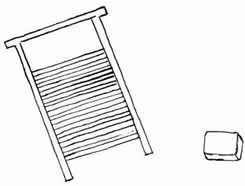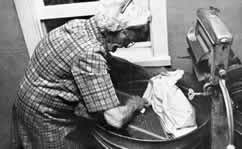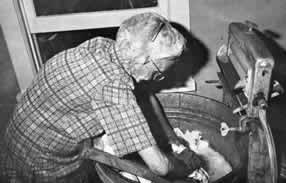 |
Volume III, No. 2, Winter 1975 |
WASHBOARD WASHING
by Donna Scott
Photographs by Stephen Hough
 Everything seems to change, but whether the
change is for good or bad is a matter of
opinion. After watching Mary Moore wash
clothes on the washboard as every woman
used to do, it seems the change was for the
better. But Mary does not agree, for she says
all the machines we have do not get clothes as
clean as rubbing and scrubbing them on the
board and boiling them. Very few other
women will give up the convenience of their
automatic machines, but many do agree with
Mary that the modern way just does not get
clothes as clean.
Everything seems to change, but whether the
change is for good or bad is a matter of
opinion. After watching Mary Moore wash
clothes on the washboard as every woman
used to do, it seems the change was for the
better. But Mary does not agree, for she says
all the machines we have do not get clothes as
clean as rubbing and scrubbing them on the
board and boiling them. Very few other
women will give up the convenience of their
automatic machines, but many do agree with
Mary that the modern way just does not get
clothes as clean.
Things have changed even for Mary. She now has running water and electricity, but she still prefers to wash on an old-fashioned washboard as she has done for years. "I've got an old machine that was given me, but I never did use it. I wash yet on the board." She used to do as many as eight washings a week to support her family. "I got from fifty cents to seventy-five cents and a dollar for a washing," she said proudly. "I worked for myself and made good money. I've washed for most everybody in the country."
In the days before washing machines and dryers were invented and electricity reached the farms, one day a week was always set aside for washing. Early Monday morning it was a common sight to see the wife and daughters of the family outside carrying water and building a fire beneath the old family kettle.
Getting water is nothing now compared to years ago when women had to carry it in bucketsful from a creek or spring or draw it from a well. After carrying it to the house, the wash water had to be heated, during the winter water was often he ed and the clothes boiled on the kitchen stove in a big copper wash kettle. The rinse water was also carried in, but usually was not heated. In summer to avoid building such a big fire in the stove and making the kitchen even hotter than it was, many women heated the water outside in the family's three-legged black iron kettle set up on three rocks. So, many women did the washing outside under a cool shade tree to avoid carrying the water farther into the house.
Though well water is hard, in the Ozarks it is not too hard for washing. Because they preferred the whiter clothes washed in soft water, many women kept a barrel under an eave of the house to collect rain water, especially used for washing fine clothes. Some people built a cistern right by the kitchen with a hand pump in a kitchen sink. That provided plenty of soft water without carrying, but very few had such conveniences.The soap for rubbing was a barsoap which was rubbed directly on the clothes and board. The brand, if a commercial soap, made no difference. The homemade lye soap was good to take out the dirt, though hard on hands.
Some women cooked some of their lye soap only partly so it would stay in a liquid form. This was nice to put in the kettle of clothes for boiling.
The most important part in washing was the washboard. The frame and legs were wooden. It had a corrugated metal area in the center for rubbing the clothes and a shelf for the bar of soap above it. Rubbing the clothes up and down along the ridges removed the dirt ground into the fabric. "The harder you bear down on the clothes and the faster you go, the quicker it is done.
A couple of hours would do a pretty good washing if you was kind of fast," Mary said. Most women took longer than that, spending the whole day to complete the washing process for a large family. Crude as the washboard seems to us now, it was quite a labor saver when it first became available. Before that women had to beat clothes with a stick, rub them together, rub them on rocks in the creek or any other way they could devise to get out the dirt.
[63]
Three large zinc or wooden tubs were best for washing--one for soaping, two for rinsing. They were set on a bench or a stand to save bending over. However, many a woman did the family washing for years with but one tub. She would wash each load one by one, setting them aside, then get fresh water and rinse each load one by one, then get more fresh water to rinse each load again. Owning three tubs was much nicer because a wringer could be put between them.
Having a wringer, even a hand turned one, saved a lot of labor, but years ago not many women in the rural Ozarks had them. Instead of running the clothes through the wringer, they had to wring them out by hand. A convenient wringer was one on a stand which held the two tubs like Mary's in the Photographs. For greater convenience, the wringer could swing around to serve the wash tub, two rinse tubs and allow clothes from the last rinse to fall in a basket.
After all the equipment was ready and while the water was heating in the kettle, it was a good time to sort the laundry. "Knowing how to sort your clothes is the main part of your washing," Mary said. Though sorting required little physical labor, the job was difficult and time consuming. Sorting involved putting colors together that wouldn't fade, putting similar fabrics together for special handling and putting clothes together according to their dirtiness.
All white items went together to keep them white and bright and to avoid the possiblility of colors fading off onto them. The early colored clothes were not treated as ours are today and faded easily. So women had to be very careful about mixing colors. They wouldn't put anything that faded in with other clothes that might get stained.
How dirty the clothes were also made a difference in sorting. Putting very dirty clothes in with fairly clean ones made the water so dirty that the cleaner clothes wouldn't look much better when taken out than they did before.
White clothes included things such as sheets, pillow cases, table cloths, white shirts and other white garments. Another pile of light colored clothes would be towels, tea towels and underwear.
There would be at least two different piles for colored clothes, the first being for colored shirts, dresses and aprons, and the second for overalls, men's work jumpers and other heavily soiled items which faded readily.
"You rub the soap on the clothes or on the board, but it's better to rub it on the clothes."
[64]
When all preparations for washing were done, it was time to begin the actual job of washing. Mary explained to us the method she uses for washing.
Pour about three buckets of warm water into the first tub containing the washboard. Put a few white items into the tub of warm water. Piece by piece rub soap on them and also on the board.
Take special care for extra dirty places by rubbing extra soap on collars and cuffs, turning them over and rubbing the dirty portions against the board. Stand behind the board, lean over and rub with an up and down motion.
After scrubbing, turn the clothes and pillow cases inside out to keep dirt and lint from collecting in the inside corners. Having the bright side of colored clothes turned inside also protects colors from fading in the direct sunlight out on the line.
When the white clothes are clean, wring out the water by hand. Put the white clothes in the kettle of clean water for boiling. Pour liquid soap, or sprinkle chopped up lye soap or powdered soap over the clothes and fill the kettle with enough clean water to cover everything. Heat the kettle of water and boil for fifteen or twenty minutes, poking the clothes down in the soapy water from time to time.
While the white clothes boil, scrub the overalls, jumpers and other heavily soiled clothes in the tub of soapy wash water from which you just took the white clothes. Wring these garments out and set them aside for rinsing later. Do not rinse them yet, but wait until after the white and colored loads have been rinsed. Dump out the tub of soapy, soiled wash water now, for it is too dirty to use again. Rinse out the tub and refill with clean cool water.
By this time the white clothes boiling in the kettle should be ready. Dip out the clothes with a
stick and put them into this clean water. This should be the same tub you scrubbed them in before.
Don't wring out the boiling water because it is too hot. The fresh water will cool them enough so
you can rinse out the suds by hand. If there are still any soiled places, rub them out now. You
have finished washing the white clothes and are ready to rinse them. The suds and heat from these
clothes make this clean water hot enough to wash the rest of the laundry.
"When I first come here to the Berg I washed--that's been several years ago. My oldest son was just nine. Now he's 75 so you know that's been a long time ago." |
"When you get this done I boil them. That really makes them clean." |
[65]
Wring out the white clothes either by hand or through a wringer and put them into the first tub of rinse water. This tub contains clean cold water and blueing.
Blueing is a commercial product which makes white clothes even whiter and colored clothes brighter. The blueing often consists of three little balls tied in a cloth bag and dropped in the water. Squeeze the bag slightly until the blue runs out, and hold your hands in the water to test if it is blue enough. The water needs to be blue enough that you can see your hands, but not so blue that they are hidden. When the water is just right, remove the sack containing the blueing and save it for the next wash day.
After rinsing clothes in the blueing rinse, put them through a second rinse. They are now ready to starch or hang out.
Next scrub the colored clothes in the wash water heated by the soapy white load. Scrub them just as you did the white clothes, but do not boil them, for the colors will not stand boiling. Rinse them in two rinses and hang them out on the line if you do not plan to starch them.
If you starch, you can make the starch water quite easily and conveniently in a dishpan. Slowly pour boiling water over a smoothly mixed paste of one cup of cold water and one-half cup of flour while stirring constantly. For a thinner paste, add more cold water. Dip the clothes in the starch water thoroughly. Wring them out and hang them up.
Now run the overalls which were washed earlier through the two rinse waters and the washing is done.
Just as the water was carried in, it was carried out. Since no one liked to carry water, none was wasted. The rinse water was poured on flowers or gardens or saved to slop the hogs. The cleaner soapy water might be used to mop the kitchen floor.
The clothes on the line were left until they completely dried. The fabrics would be damaged if left out in the sun and wind, so clothes were taken in as soon as they dried. Mary cautioned, "Don't made no difference what I'm doing of what I've aot to do, I never leave them on the line. Just as quick as they're dry, bring them in. Letting them blow and blow damages the clothes. That's harder on them than wearing. You can save a lot that way."
Most women today own a washer and would much rather put their laundry in to be washed, rinsed and spun dry automatically. They would also rather throw them in a dryer than have to spend the time and effort hanging them outside. But Mary Moore, still going strong at ninety-four, wouldn't take anything for how really clean her clothes get from washboard washing and how good they smell from hanging outside in the fresh Ozark air.
"You take a hot day and this is a hot job."
[66]
Copyright © 1981 BITTERSWEET, INC.
Next Article | Table of Contents | Other Issues


